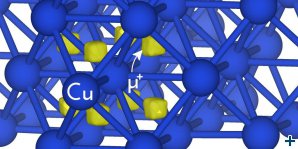Where is the muon? A review of simulation methods
Scientists review approaches used to computationally predict muon sites and interaction parameters.
Inês Crespo, SINE2020, 30/09/2016
Contact: Pietro Bonfà, Uni. Parma

An iso-energy surface showing the position of the tetrahedral interstitial sites in a copper crystal (blue balls). The problem of identifying stable muon sites in crystalline materials is pictorially represented.
Scientists use muons to study how substances behave at the very small scale. To understand why materials behave as they do, we need to know what their atoms are doing, which can be seen by using muons. Muons are thus used e.g. for studying magnetism, superconductivity, chemical reactions, molecular dynamics, diffusion and charge transport.
To analyse the data resulting from experiments, scientists use data treatment software. Thanks to modern simulation methods, they can know ever more accurately the location of muons during experiments and how they interact with samples.
Within the SINE2020 Data Treatment Software Activity, Pietro Bonfà and Roberto De Renzi from the University of Parma in Italy reviewed approaches used to provide quantitative estimations of the following questions:
- Where is the muon?
- Is it a passive probe?
- How is the muon-sample interaction?
They discuss the possible approaches to use for diverse situations. The review is published in the Journal of the Physical Society of Japan, 85, 091014 (2016), DOI: http://dx.doi.org/10.7566/JPSJ.85.091014.






